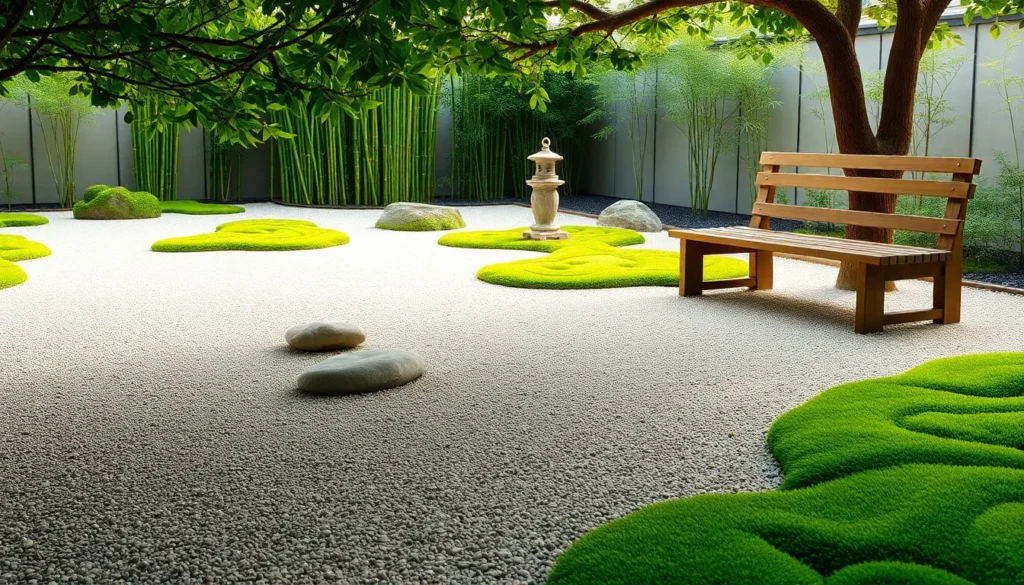We’ve all felt that overwhelming need to escape the chaos of daily life and find a peaceful sanctuary right in our own backyard. Zen gardens offer the perfect solution – transforming any outdoor space into a tranquil retreat that promotes mindfulness and inner calm.
These minimalist landscapes aren’t just beautiful to look at; they’re powerful tools for stress relief and meditation. Whether you’re working with a sprawling yard or a tiny balcony we’ll show you how to create your own slice of serenity using simple elements like sand stones and carefully chosen plants.
From traditional Japanese rock gardens to modern interpretations that blend Eastern philosophy with contemporary design we’re about to explore creative ideas that’ll help you create a meditative oasis. Ready to discover how these timeless designs can transform both your space and your state of mind?
Create a Traditional Japanese Rock Garden With Raked Gravel
Rock gardens represent the purest form of Zen garden design, transforming your outdoor space into a meditative industry. We’ll guide you through the essential elements that create these timeless sanctuaries.
Choose the Right Type of Sand or Gravel
Selecting the proper material foundation determines your garden’s authentic appearance and maintenance requirements. We recommend decomposed granite for its natural gray color and excellent compaction properties, making it ideal for crisp raking patterns. Fine pea gravel offers durability and weather resistance, though it requires more effort to maintain smooth lines.
White sand creates striking visual contrast against darker rocks but shows debris more readily than neutral tones. Consider your climate when making this choice, as certain materials perform better in wet conditions. Local stone suppliers often carry crushed stone screenings that provide the traditional appearance while supporting regional aesthetics.
Depth matters significantly for pattern retention and weed prevention. We suggest spreading your chosen material 2 to 3 inches deep across the entire garden area. This thickness allows for proper raking while preventing underlying soil from showing through the surface.
Master the Art of Raking Patterns
Raking techniques create the flowing water illusion that defines traditional rock gardens. We start with straight parallel lines extending across the entire surface, maintaining consistent spacing of approximately 3 to 4 inches between each groove. These linear patterns represent calm water and provide the foundation for more complex designs.
Circular patterns around rocks symbolize ripples where water meets obstacles in nature. Begin these circles close to each stone’s base and gradually widen the spacing as you move outward. The key lies in maintaining smooth, continuous curves that appear naturally formed rather than mechanically precise.
Wave patterns add ever-changing movement to your garden’s visual flow. We create these by gently curving parallel lines in rhythmic undulations across the surface. Practice on a small section first to develop the muscle memory needed for consistent wave spacing and amplitude.
Daily raking maintains both the garden’s appearance and your meditative practice. Early morning sessions work best when dew hasn’t yet disturbed the previous day’s patterns.
Position Focal Point Rocks Strategically
Stone placement follows ancient principles that create visual balance and spiritual significance. We arrange rocks in odd numbered groupings, typically three or five stones, to achieve natural asymmetry that pleases the eye. The largest stone serves as the primary focal point, positioned off center to avoid static symmetry.
Vertical orientation emphasizes strength and permanence in your design. Place taller stones with their longest dimension upright, creating mountain like silhouettes that anchor the composition. These upright elements contrast beautifully with the horizontal raked patterns surrounding them.
Smaller accent stones support the main grouping without competing for attention. We position these secondary rocks at varying distances from the primary stone, creating depth and preventing the arrangement from appearing flat or monotonous.
Consider viewing angles when finalizing stone positions. Walk around your garden space to ensure the arrangement looks balanced from multiple perspectives, especially from windows or seating areas where you’ll observe the garden most frequently.
Design a Miniature Zen Garden for Small Spaces
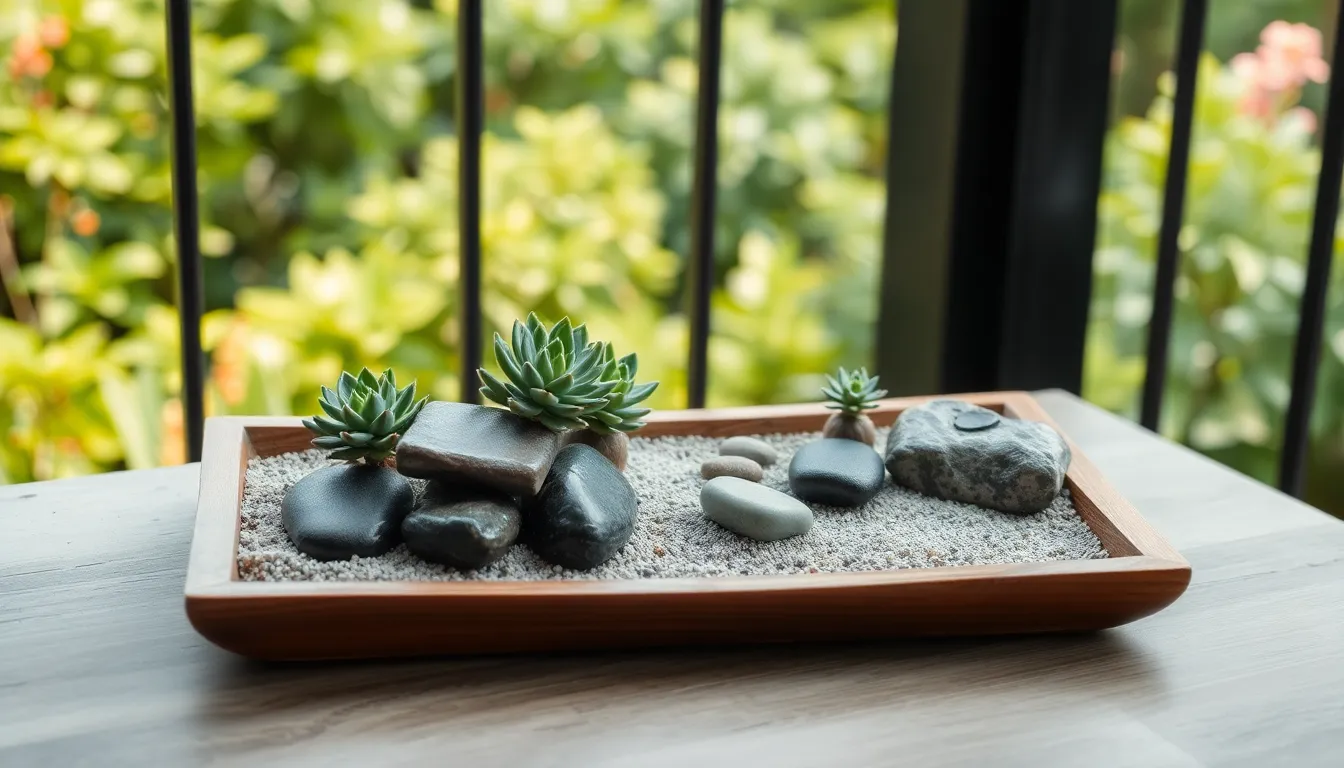
We can create a peaceful meditation sanctuary even in the smallest areas by crafting a miniature zen garden that captures the essence of traditional Japanese design. These compact gardens offer the same stress-relieving benefits as their full-sized counterparts while fitting perfectly on balconies, courtyards, or indoors.
Select Appropriate Container Size and Materials
Container selection forms the foundation of our miniature zen garden design. We recommend using shallow trays, dishes, or boxes that provide adequate space for sand, rocks, and decorative elements while maintaining the proper proportions for visual harmony.
Material choices significantly impact both durability and aesthetic appeal. Wood containers offer natural warmth and blend seamlessly with organic elements, while stone options provide timeless elegance and weather resistance. Ceramic vessels deliver refined beauty and work exceptionally well for indoor installations.
Size considerations depend on our available space and intended use. Tabletop versions measuring 12-18 inches work perfectly for desk meditation, while larger 24-36 inch containers create impressive focal points for patios or meditation rooms.
Scale Down Traditional Elements Effectively
Sand or gravel serves as the essential base material for creating flowing patterns with miniature rakes. We fill our containers with fine-grain sand or small pea gravel to achieve the smooth, rakeable surface that’s fundamental to zen garden aesthetics.
Rock arrangement follows traditional principles while adapting to smaller proportions. We position stones in odd-numbered groupings to create visual balance, placing larger specimens as focal points and smaller ones as supporting elements that reflect nature’s random beauty.
Plant selection requires careful consideration of size and growth patterns. Small succulent varieties, moss patches, and miniature bamboo species thrive in container environments without overwhelming the garden’s minimalist design. These plants won’t outgrow their designated spaces and maintain the serene atmosphere we’re cultivating.
Incorporate Portable Meditation Features
Portable elements enhance the meditative experience while maintaining flexibility in our garden design. Small fountains create soothing water sounds, while miniature statues or candles add spiritual focal points that can be easily rearranged as our needs change.
Meditation tools integrate seamlessly into our compact design. We include small bells for mindfulness practices or meditation stones that serve both decorative and functional purposes, helping us center our thoughts during contemplation sessions.
Lighting options transform our miniature garden into an evening sanctuary. Soft, warm LED lights or battery-operated lanterns create peaceful ambiance without requiring permanent electrical installations, making them perfect for indoor or outdoor use.
Build a Water Feature Zen Garden With Flowing Elements
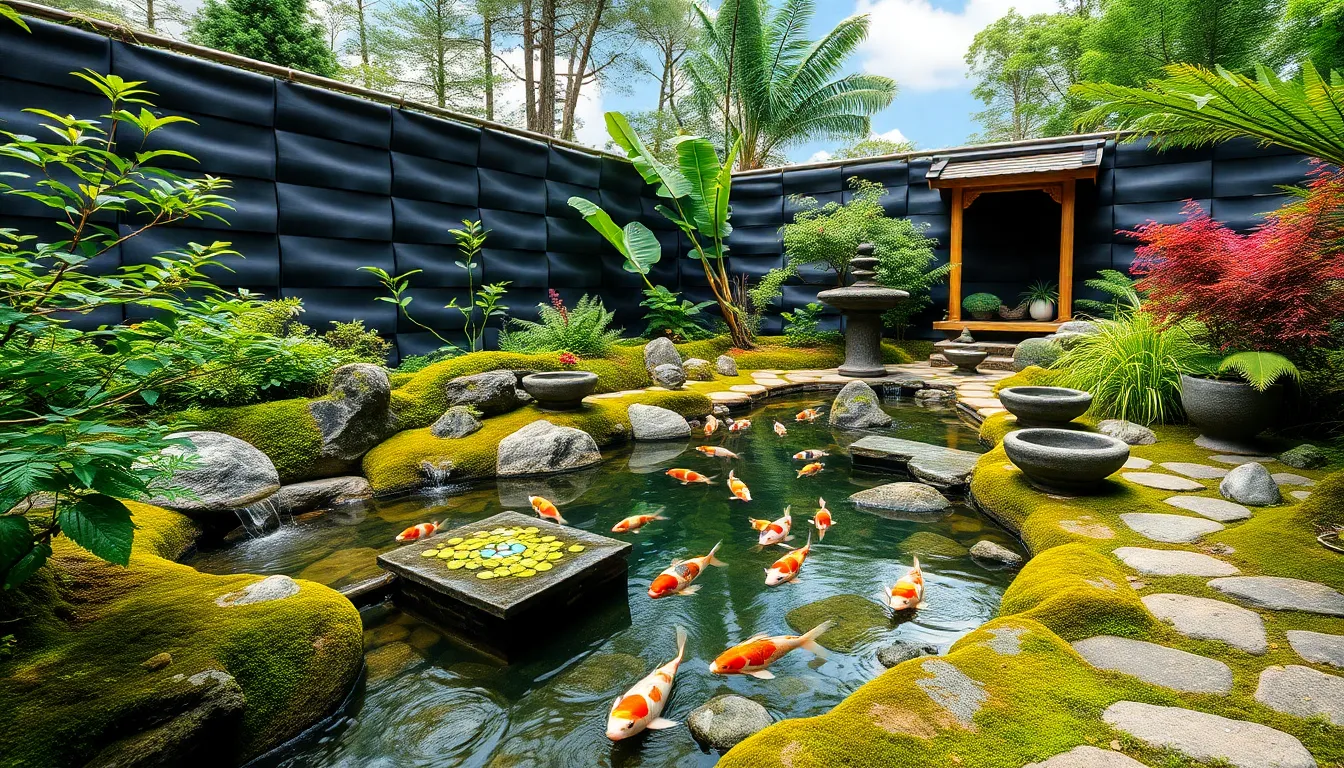
Water transforms any outdoor space into a meditative sanctuary through its natural ability to mask noise and create peaceful ambiance. Flowing elements like streams (yarimizu) and waterfalls (taki) form the foundation of water-centric zen gardens that promote tranquility and mindfulness.
We recommend incorporating recirculating water systems that use black stone panels and natural ledge stones for both visual appeal and construction durability. These materials create gentle water movement while providing the soothing sounds essential for meditation. Compact layouts benefit from recirculating pumps that maintain continuous flow without requiring external water sources.
Stone pathways and stepping stones alongside streams enhance the meditative walking experience we seek in zen garden design. The combination of flowing water and natural stone creates harmony between movement and stillness that defines authentic Japanese garden principles.
Install a Simple Bamboo Fountain
Bamboo fountains (shishi-odoshi) deliver gentle, rhythmic water sounds that enhance meditation while requiring minimal installation effort. These traditional features use a single length of bamboo positioned over rocks or gravel to create consistent water flow patterns.
We find bamboo fountains particularly effective because they integrate seamlessly with lush greenery and natural materials common in zen gardens. The minimalist design reinforces the zen aesthetic without overwhelming other garden elements like stones or plants.
Installation involves positioning the bamboo fountain atop a stable rock base with access to a small water source or recirculating system. This setup creates the distinctive bamboo sound that adds authentic Japanese character to any meditation space.
Create a Peaceful Koi Pond Centerpiece
Koi ponds serve as stunning centerpieces that reflect surrounding stones and sky while adding movement through colorful fish. These water features become focal points that draw attention and encourage contemplation during meditation sessions.
We recommend designing pond edges with moss, ferns, and carefully placed stones to create natural transitions between water and surrounding garden elements. This landscaping approach maintains the organic flow essential for zen garden harmony.
Filtration systems ensure water clarity and fish health while supporting the pond’s role as a meditation centerpiece. Clear water enhances reflections and allows visitors to observe koi movement, which adds ever-changing visual interest to the static garden elements.
Add Stone Basins for Sound and Reflection
Stone water basins (tsukubai or chōzubachi) provide traditional handwashing and meditation opportunities while creating gentle dripping sounds that enhance garden atmosphere. These authentic features connect modern zen gardens to historical Japanese design principles.
We position stone basins near seating areas or along pathways where the sound of dripping water can be fully appreciated during quiet moments. The rhythmic water sounds create natural white noise that supports meditation and mindfulness practices.
Pairing stone basins with lanterns or potted plants adds visual interest while maintaining authenticity in zen garden design. This combination creates intimate spaces within larger gardens where visitors can pause for reflection and contemplation.
Incorporate Living Plants Into Your Zen Garden Design

Adding living elements to your meditation space creates a deeper connection with nature while maintaining the peaceful simplicity that defines Zen aesthetics.
Choose Low-Maintenance Moss and Ferns
Moss and ferns bring natural tranquility to your Zen garden while requiring minimal upkeep throughout the seasons. These shade-loving plants thrive in areas where other vegetation struggles, making them perfect for covering rocks or creating lush carpet-like groundcover. We recommend positioning moss varieties like cushion moss or sheet moss around the base of larger stones to create visual continuity between hardscape and softscape elements.
Ferns add gentle texture and movement without overwhelming the garden’s minimalist design philosophy. Boston ferns, Japanese painted ferns, and maidenhair ferns work particularly well in meditation spaces because they maintain their elegant appearance with little intervention. Position these plants in naturally shaded areas where they’ll receive filtered light and consistent moisture.
Plant Bamboo for Natural Privacy Screens
Bamboo creates elegant privacy screens while adding natural movement and sound to your meditation environment. This versatile plant provides year-round screening without requiring extensive maintenance once established. We suggest using contained planters or root barriers to control bamboo’s natural spreading tendency and maintain your garden’s organized appearance.
Clumping bamboo varieties like fountain bamboo or Buddha’s belly bamboo offer excellent privacy without aggressive growth patterns. Running bamboo types such as golden bamboo create denser screens but require more careful management through containment systems. Position bamboo strategically along property lines or between meditation areas to create intimate spaces for reflection.
The gentle rustling of bamboo leaves adds a natural soundtrack that enhances meditation sessions while blocking unwanted noise from surrounding areas.
Select Ornamental Grasses for Gentle Movement
Ornamental grasses introduce soothing movement that responds to every breeze while maintaining the clean lines essential to Zen garden design. These low-maintenance plants create peaceful ambiance through their gentle swaying motion and soft rustling sounds. We recommend choosing varieties that complement your garden’s scale and existing plant palette.
Fountain grass, Japanese forest grass, and mondo grass work exceptionally well in meditation spaces because they provide subtle texture without demanding attention. These grasses require minimal care once established and offer seasonal interest through changing colors and seed heads. Position ornamental grass varieties in groups of odd numbers to create natural-looking clusters that draw the eye without creating visual chaos.
Shorter grass varieties work well as borders or groundcover replacements, while taller specimens can serve as living sculptures that define different areas within your peaceful sanctuary.
Establish Pathways and Walkways for Mindful Movement
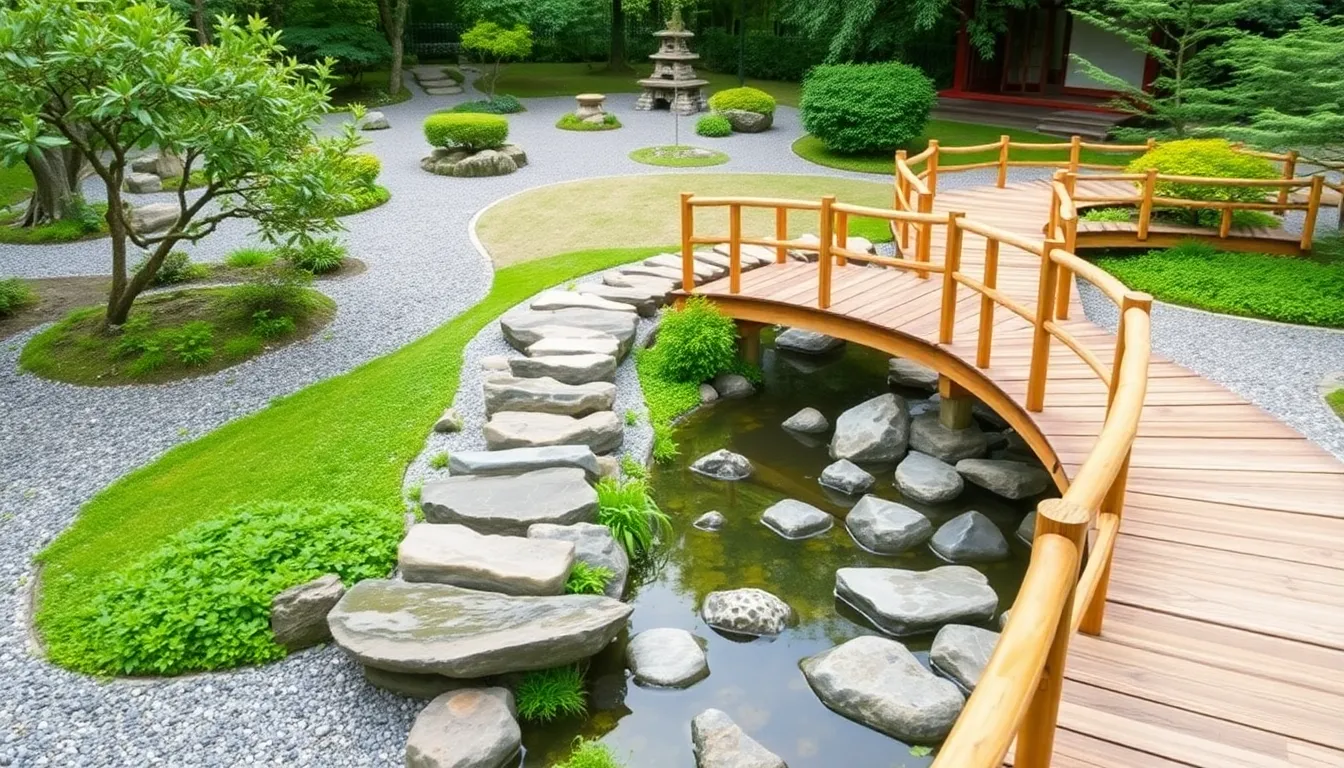
Building on the foundation of living elements in our Zen garden design, we’ll now create pathways that invite contemplative walking and deepen our meditation practice. Japanese Zen garden paths focus on tranquil minimalism through carefully arranged landscapes that promote calmness and reflection.
Use Stepping Stones for Irregular Patterns
Irregular stepping stone patterns transform ordinary garden walks into meditative experiences. Placing stones in deliberate yet seemingly random arrangements encourages us to slow down and appreciate our surroundings with each mindful step.
We recommend spacing stones 18-24 inches apart to create a natural rhythm while walking. Choose flat stones of varying sizes to add visual interest and maintain the organic feel essential to Zen design principles.
The beauty of irregular patterns lies in their ability to break up straight sightlines. This design technique draws our attention to different garden elements as we navigate the pathway, improving our overall awareness during meditation walks.
Install Wooden Boardwalks Over Water Features
Wooden boardwalks over water features create serene connections between land and aquatic elements in our Zen gardens. Installing these structures over small ponds or streams invites contemplation while providing peaceful access to water’s calming presence.
We suggest using weather-resistant cedar or teak planks that blend naturally with the garden’s aesthetic. Position boardwalks 6-12 inches above water level to create gentle sounds as water flows beneath the walking surface.
Bamboo railings enhance the Asian garden atmosphere while providing subtle guidance along the pathway. These additions integrate seamlessly with existing water features like recirculating systems or stone basins we’ve already incorporated into our design.
Create Curved Gravel Paths for Meditation Walks
Curved gravel paths offer ideal surfaces for focused meditation walks through our Zen garden spaces. Designing pathways with gentle curves using fine gravel or sand allows us to concentrate on our footsteps while connecting with surrounding nature.
We recommend using decomposed granite or fine pea gravel for optimal walking comfort and visual appeal. Create paths 2-3 feet wide to accommodate comfortable single-file walking while maintaining the intimate garden scale.
Gentle curves naturally slow our walking pace compared to straight pathways. This design feature encourages mindful movement as we follow the path’s natural flow, deepening our meditation practice with each deliberate step through the serene industry.
Add Seating Areas for Contemplation and Relaxation
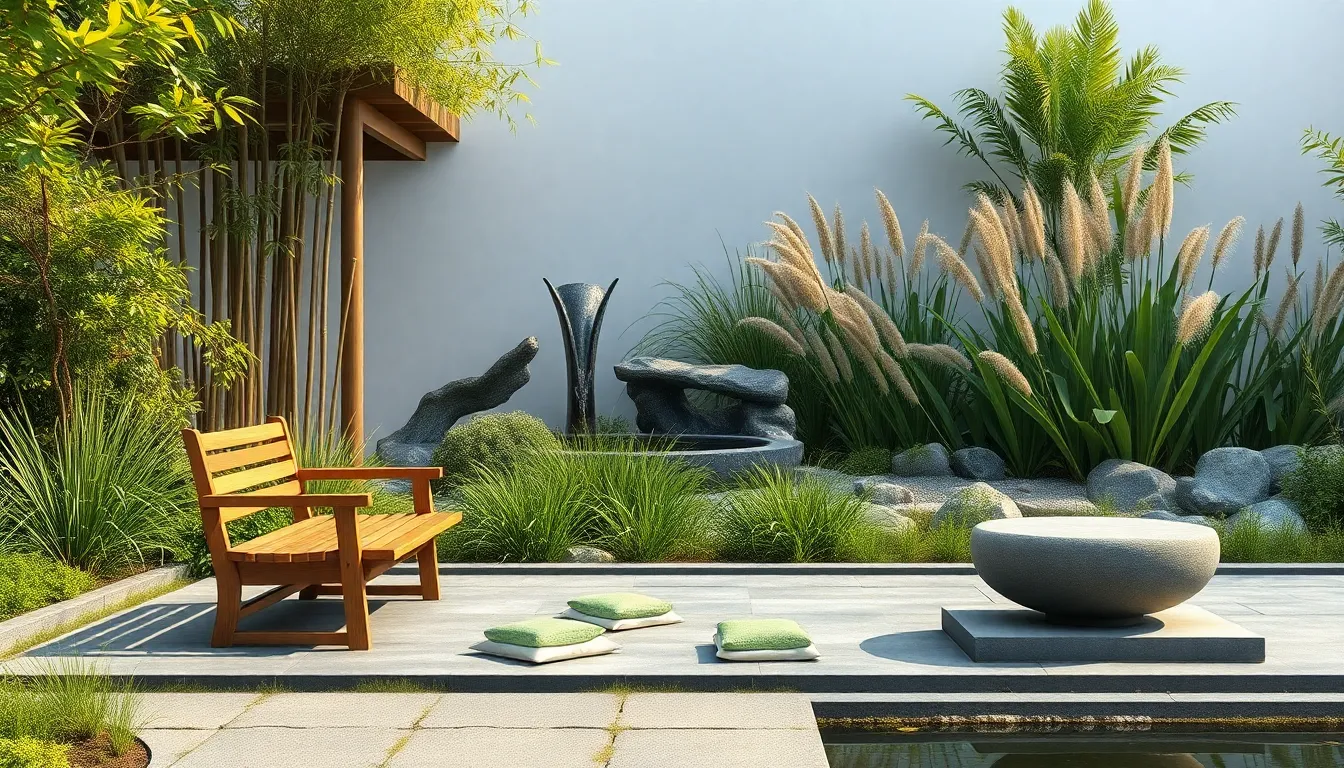
Thoughtfully placed seating transforms your zen garden into a true sanctuary for meditation and reflection. Creating designated spaces for rest allows visitors to fully immerse themselves in the tranquil atmosphere you’ve cultivated.
Position Simple Wooden Benches Strategically
Wooden benches serve as perfect contemplation stations when positioned in serene locations throughout your zen garden. We recommend placing these simple seats near water features like bamboo fountains or stone basins to maximize the peaceful ambiance. Trees and tall bamboo screens provide natural shade and create intimate alcoves for deeper meditation sessions.
Strategic placement requires considering both comfort and visual harmony. Position benches at slight angles to face your garden’s main focal points, such as raked gravel patterns or rock arrangements. Cedar and teak benches offer weather resistance while maintaining the natural aesthetic that complements your garden’s organic elements.
Spacing between benches encourages solitary reflection while accommodating multiple visitors. We suggest placing seats at least 15-20 feet apart to maintain privacy and prevent distractions during meditation practice.
Create Ground-Level Meditation Cushion Spaces
Ground level seating areas offer the most authentic zen meditation experience through direct connection with the earth. Low cushions and meditation mats can be arranged on flat stone platforms or wooden decking to create comfortable sitting areas. These spaces work particularly well when surrounded by moss gardens or small ornamental grasses that provide natural boundaries.
Cushion areas require weather protection and easy storage answers. Consider installing retractable awnings or positioning these spaces under pergolas to shield meditation sessions from sun and light rain. Waterproof storage boxes nearby allow quick setup and protection of cushions when not in use.
Natural windbreaks enhance the intimacy of ground level meditation spots. Small groupings of rocks or strategically placed plantings of ferns create cozy meditation nooks that feel separate from the larger garden space.
Install Stone Seats Near Focal Points
Stone seats provide permanent seating answers that seamlessly integrate with your zen garden’s mineral elements. Position these ergonomically designed seats near major focal points like koi ponds or prominent rock groupings to create natural viewing areas. Natural stone materials like granite or sandstone complement existing hardscape features while providing comfortable support during extended contemplation sessions.
Curved stone benches follow the organic lines found throughout traditional zen gardens. These seats can wrap around water features or follow the gentle curves of your gravel pathways, creating fluid transitions between different garden zones. The thermal mass of stone provides comfortable seating temperatures throughout most seasons.
Integration with existing industry features ensures stone seats appear naturally placed rather than added afterthoughts. We recommend partially embedding seat bases into surrounding gravel or positioning them against existing retaining walls to create the impression they’ve always been part of the garden’s design.
Include Symbolic Elements and Decorative Accents
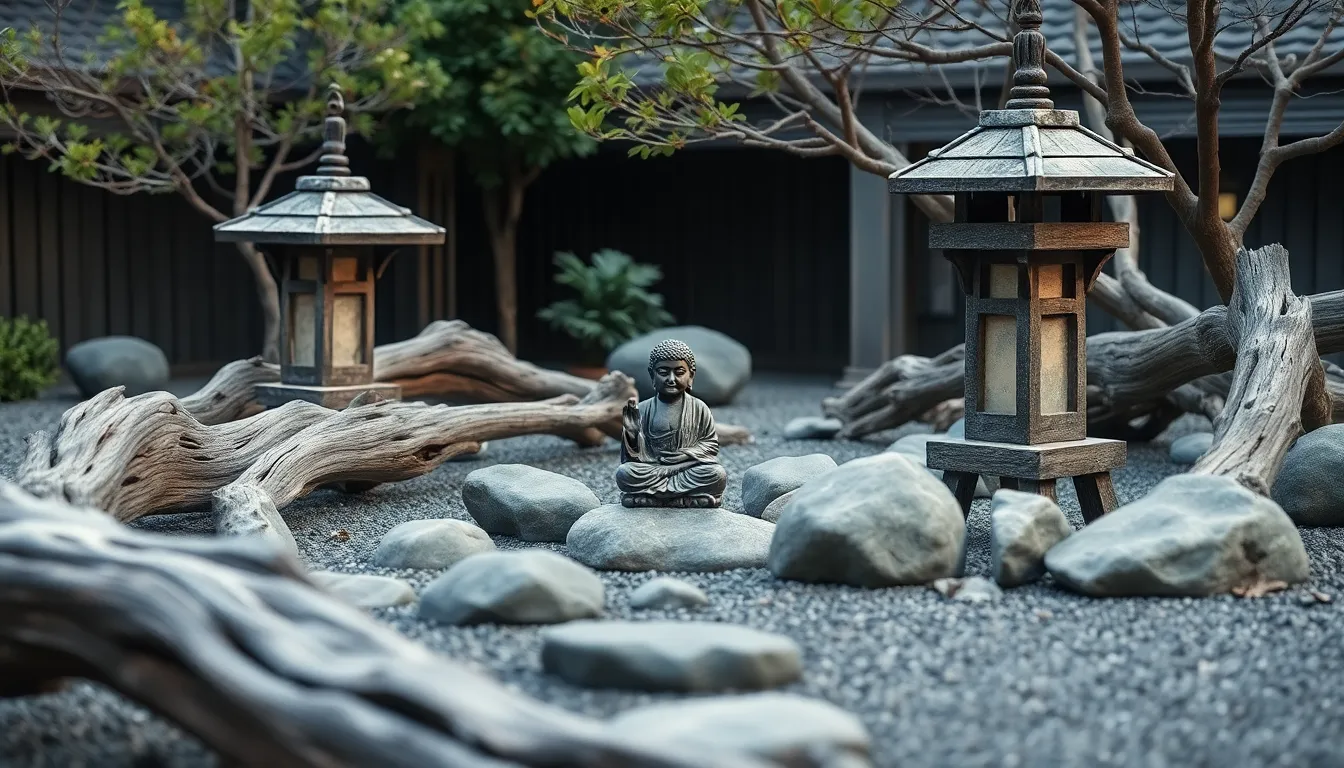
Decorative elements transform your zen garden from a simple arrangement into a meaningful sanctuary that speaks to your soul. These carefully chosen accents create layers of visual interest while maintaining the peaceful simplicity that defines zen garden design.
Place Traditional Lanterns for Ambient Lighting
Stone lanterns serve as both functional lighting and symbolic guardians of your meditation space. We recommend positioning these traditional fixtures near pathways and seating areas to create soft pools of light that guide evening contemplation sessions. Japanese stone lanterns like yukimi-dōrō (snow viewing lanterns) work beautifully beside water features, where their reflection doubles the ambient glow.
Solar powered versions offer modern convenience while preserving the authentic aesthetic your zen garden deserves. Position lanterns at varying heights throughout your space to create depth and visual rhythm without overwhelming the minimalist design. The gentle illumination from these fixtures encourages extended meditation practice as daylight fades.
Add Meaningful Sculptures and Statuary
Buddha statues bring profound spiritual significance to your zen garden while serving as natural focal points for meditation. We place these sculptures strategically where they catch morning or evening light, creating dramatic shadows that shift throughout the day. Choose statues made from weather resistant materials like stone or bronze to ensure they withstand outdoor conditions while developing a beautiful patina over time.
Consider the size and positioning carefully to maintain proper scale within your garden space. Smaller gardens benefit from compact Buddha figures, while larger spaces can accommodate more substantial sculptures that command attention from multiple viewing angles. Abstract sculptures or simple geometric forms also work well if religious imagery doesn’t align with your personal preferences.
Incorporate Natural Driftwood and Found Objects
Natural driftwood adds organic textures and unique character that manufactured decorations simply can’t replicate. We search for pieces with interesting grain patterns, weathered surfaces, or natural curves that complement your garden’s existing elements. These found objects create conversation between the designed and the discovered, adding authenticity to your zen space.
Arrange driftwood pieces as natural seating, sculptural elements, or boundaries between different garden zones. Weathered stones, interesting branches, and naturally formed root systems also serve as compelling decorative accents that connect your garden to the broader natural industry. The key lies in selecting pieces that feel intentional rather than randomly placed, maintaining the thoughtful curation that defines successful zen garden design.
Maintain Your Zen Garden Throughout the Seasons
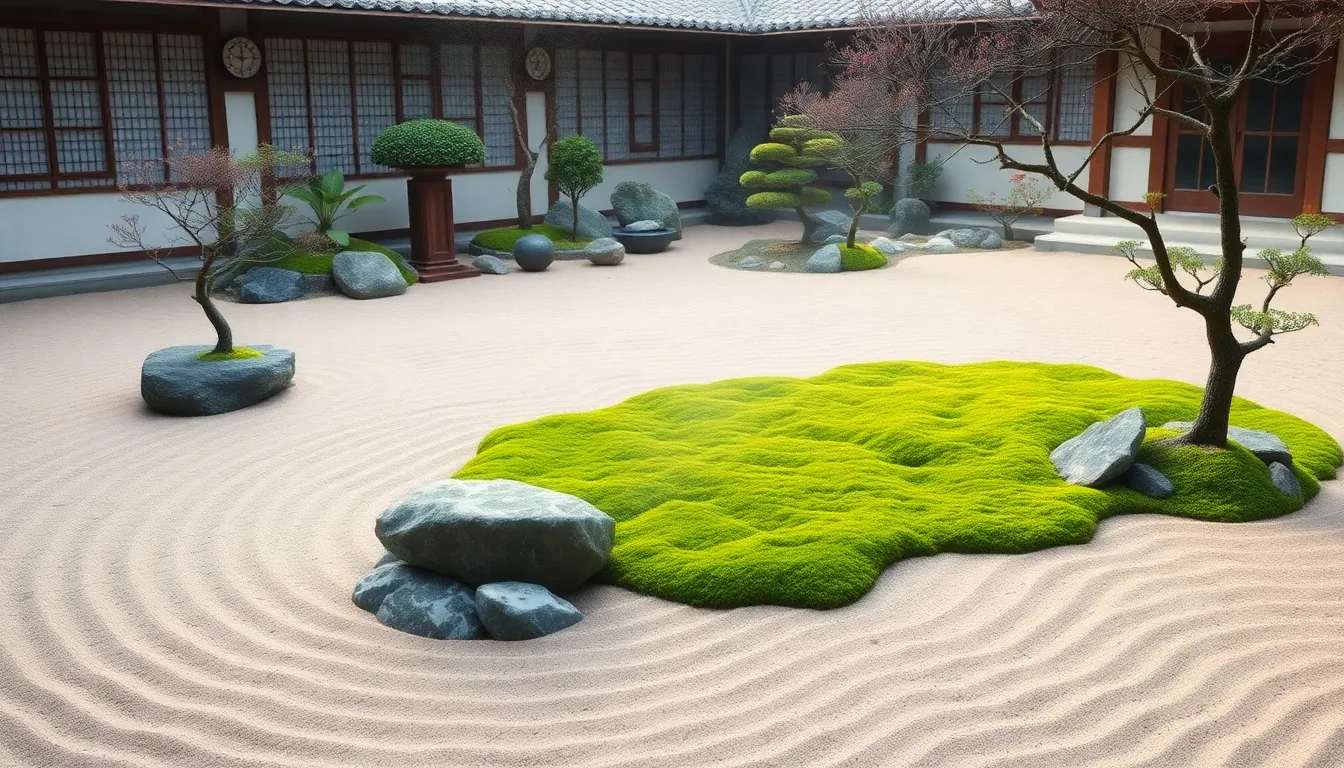
Seasonal maintenance preserves the meditative qualities that make your zen garden a peaceful sanctuary. We’ll guide you through essential practices that keep your garden balanced and serene year-round.
Establish Regular Raking and Cleaning Routines
Weekly raking sessions transform your zen garden maintenance into meditation practice. Draw straight lines, circular patterns, or flowing wave designs through your sand or gravel to maintain the visual representation of water movement. This repetitive motion calms the mind while preserving your garden’s aesthetic appeal.
Remove fallen leaves and debris immediately to protect your garden’s minimalist design. Twigs, seed pods, and other natural elements can disrupt the carefully crafted patterns in your raked surfaces. We recommend checking your garden every few days during autumn when leaf fall peaks.
Clean stone elements monthly to maintain their natural beauty. Brush away algae, moss buildup, or dirt accumulation from focal point rocks and stepping stones. This simple practice ensures your garden’s symbolic elements remain prominent features that draw the eye and encourage contemplation.
Protect Delicate Elements From Weather Damage
Keep moss consistently moist during dry periods to preserve its vibrant green color. Spray gentle mists over moss-covered areas twice weekly when rainfall drops below normal levels. Direct sunlight exposure for extended periods can damage or kill moss patches that anchor your garden’s natural elements.
Prune and trim plants seasonally to maintain their health and shape. Cut back ornamental grasses before new growth begins in spring, and remove dead bamboo canes to encourage fresh shoots. These practices prevent weather damage while preserving the clean lines essential to zen garden aesthetics.
Cover sensitive plants during harsh weather conditions to extend their growing season. Use breathable fabric covers for delicate ferns and small shrubs when temperatures drop below their tolerance levels. Container plants may need relocation to protected areas during severe storms or extended freezing periods.
Adapt Seasonal Decorations Mindfully
Rotate container plants indoors when winter approaches to protect tender varieties. Small potted elements like miniature maples or delicate succulents benefit from climate-controlled environments during cold months. This practice maintains living elements without compromising the garden’s winter beauty.
Update plant selections thoughtfully to reflect seasonal changes while preserving zen principles. Replace summer annuals with winter-hardy evergreens that provide subtle color variations. Choose plants with simple forms that complement rather than compete with your garden’s existing focal points.
Adjust lighting features seasonally to enhance your garden’s ambiance throughout the year. Solar path lights work well during longer summer evenings, while battery-powered lanterns provide reliable illumination during shorter winter days. Position lighting elements to highlight key features without overwhelming the space’s natural tranquility.
Conclusion
Creating your own zen garden becomes an achievable goal when you understand the fundamental principles we’ve outlined. Whether you’re working with a sprawling backyard or a small tabletop space the key lies in embracing simplicity and intentional design choices.
We’ve shown you that authentic zen gardens don’t require expensive materials or complex installations. With basic elements like sand gravel stones and carefully selected plants you can create a meditation sanctuary that serves your daily wellness needs.
The journey of building and maintaining your zen garden will become as rewarding as the peaceful moments you’ll spend within it. Start small experiment with different elements and let your space evolve naturally as your understanding deepens.
Your zen garden awaits – it’s time to take that first mindful step toward creating your personal oasis of tranquility.
Frequently Asked Questions
What is a Zen garden and what are its main benefits?
A Zen garden is a minimalist landscape designed to create a peaceful sanctuary for meditation and stress relief. These gardens use simple elements like sand, stones, and plants to promote tranquility and mindfulness. The main benefits include reducing daily stress, providing a space for meditation, and creating a serene environment that helps escape life’s chaos, regardless of your available outdoor space size.
What materials are best for creating authentic Zen garden sand patterns?
The best materials for authentic Zen garden sand patterns include decomposed granite and fine pea gravel. These materials offer both visual appeal and practical benefits for maintenance. They create the perfect texture for raking patterns that simulate flowing water, including straight lines, circular designs, and wave patterns that are essential to traditional Japanese rock garden aesthetics.
Can I create a Zen garden in a small space?
Yes, you can absolutely create a miniature Zen garden in small spaces. Use shallow trays or boxes made from wood, stone, or ceramic as containers. Scale down traditional elements by using fine-grain sand for raking patterns, small rocks arranged in odd-numbered groupings, and compact plants like small succulents and moss to maintain the minimalist design while creating a peaceful meditation sanctuary.
How should I arrange rocks in my Zen garden?
Arrange rocks in odd-numbered groupings with vertical orientations to achieve visual balance and depth. This strategic placement creates focal points that draw the eye and enhance the garden’s meditative qualities. The asymmetrical arrangement follows traditional Japanese design principles and helps create a natural, harmonious appearance that supports contemplation and peaceful reflection.
What water features work best in Zen gardens?
Effective water features for Zen gardens include recirculating water systems with black stone panels, bamboo fountains for gentle sounds, koi ponds as contemplative focal points, and stone water basins that create dripping sounds. These features should integrate seamlessly with natural elements while maintaining the garden’s tranquil ambiance and connecting to historical Japanese design principles.
Which plants are suitable for Zen gardens?
Low-maintenance plants that maintain simplicity work best in Zen gardens. Recommended options include moss and ferns for shaded areas, bamboo for natural privacy screens, and ornamental grasses for gentle movement. Small succulents are perfect for miniature gardens. These plants should enhance tranquility without overwhelming the minimalist design or requiring extensive maintenance that disrupts the peaceful atmosphere.
How do I create pathways in my Zen garden?
Create mindful pathways using irregular stepping stones spaced 18-24 inches apart for natural rhythm, wooden boardwalks over water features using weather-resistant materials like cedar or teak, and curved gravel paths with fine gravel or sand. These pathways should invite contemplative movement and transform ordinary walks into meditative experiences that deepen your connection with the garden space.
What seating options work best for Zen garden contemplation?
Strategic seating options include simple wooden benches placed near water features and focal points, ground-level meditation cushion spaces with weather protection, and stone seats that blend seamlessly with the garden design. Position seating to enhance views of key garden elements while providing comfortable support for extended contemplation sessions and meditation practice.
How often should I maintain my Zen garden?
Establish a weekly maintenance routine that includes raking sand patterns, cleaning stone elements, and removing debris. This regular care transforms maintenance into a meditative practice itself. Seasonal tasks include protecting delicate elements from weather, caring for plants by keeping moss moist and pruning growth, and rotating container plants indoors during winter to preserve the garden’s aesthetic appeal.
What decorative elements can I add to enhance my Zen garden?
Suitable decorative elements include traditional stone lanterns for ambient lighting near pathways and seating areas, meaningful sculptures like Buddha statues, and natural elements such as driftwood and found objects. These accents should maintain peaceful simplicity while adding visual interest and symbolic meaning. Choose elements that enhance rather than overwhelm the garden’s meditative qualities and minimalist design principles.

